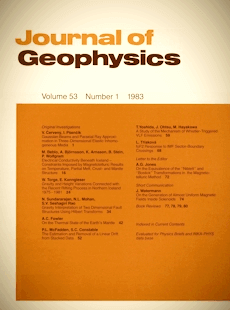Gaussian beams and paraxial ray approximation in three-dimensional elastic inhomogeneous media
Article Sidebar

Vols. 1-18 (1924-1944), ISSN 0044-2801
Main Article Content
Abstract
The elastodynamic Gaussian beams in 3D elastic inhomogeneous media are derived as asymptotic high-frequency one-way solutions of the elastodynamic equation concentrated close to rays of P and S waves. In this case, the elastodynamic equation is reduced to a parabolic (Schroedinger) equation which further leads to a matrix Riccati equation and the transport equation. Both these equations can be simply solved along the ray, the first numerically and the other analytically. The amplitude profile of the principal displacement component of the elastodynamic Gaussian beams is Gaussian in the plane perpendicular to the ray, with its maximum at the ray. The Gaussian beams are regular along the whole ray, even at caustics. As a limiting case of infinitely broad Gaussian beams, the paraxial ray approximation is obtained. The properties and possible applications of Gaussian beams and paraxial ray approximations in the numerical modelling of seismic wave fields in 3D inhomogeneous media are discussed.
 ARK: https://n2t.net/ark:/88439/y030593
ARK: https://n2t.net/ark:/88439/y030593
Permalink: https://geophysicsjournal.com/article/142
Article Details
References
Arnaud, J.A., Kogelnik, H. (1969) Gaussian light beams with general astigmatism. Applied Optics 8, 1687-1693
Babich, V.M. (1968) Eigenfunctions, concentrated in the vicinity of closed geodesics. In: Babich, V.M. (Ed.) Mathematical problems of theory of propagation of waves 9:15-63. Nauka, Leningrad (in Russian)
Babich, V.M., Buldyrev, N.J. (1972) Asymptotic methods in problems of diffraction of short waves. Nauka, Moscow
Babich, V.M., Kirpichnikova, N.Y. (1979) The boundary layer method in diffraction problems. Springer, Berlin
Babich, V.M., Popov, M.M. (1981) Propagation of concentrated acoustical beams in three-dimensional inhomogeneous media. Akust. Zh. 27:828-835 (in Russian)
Born, M., Wolf, E. (1959) Principles of optics. Pergamon Press, New York
Červeny, V. (1983) Synthetic body wave seismograms for laterally varying layered structures by the Gaussian beam method. Geophys. J. R. Astron. Soc., 73:389-426
Červeny, V., Hron, F. (1980) The ray series method and dynamic ray tracing systems for 3D inhomogeneous media. Bull. Seismal. Soc. Am. 70:47-77
Červeny, V., Klimes, L., Pšenčik, I. (1982a) Synthetic seismic wave fields in 2D and 3D inhomogeneous structures. In: G. Pliva (Ed.) Proc. of the 27th Int. Geophysical Symposium, Bratislava 198, Vol. A(I), pp. 17-28. Brno: N.E. Geofyzika
Červeny, V., Molotkov, I.A., Pšenčik, I. (1977) Ray method in seismology. Charles University, Prague
Červeny, V., Popov, M.M., Pšenčik, I. (1982b) Computation of wave fields in inhomogeneous media - Gaussian beam approach. Geophys. J.R. Astron. Soc. 70:109-128
Červeny, V., Pšenčik, I. (1983) Gaussian beams in two-dimensional elast.ic inhomogeneous media. Geophys. J. R. Astron. Soc. 72:417-433
Hubral, P. (1979) A wave front curvature approach to computing ray amplitudes in inhomogeneous media with curved interfaces. Stud. Geophys. Geod. 23:131-137
Hubral, P. (1980) Wave front curvatures in 3 D laterally inhomogeneous media with curved interfaces. Geophysics 45:905-913
Kamke, E. (1959) Differentialgleichungen. Losungsmethoden und Losungen. Vol. 1, Gewohnliche Differentialgleichungen. Leipzig
Kirpichnikova, N.J. (1971) Construction of solutions concentrated close to rays for the equations of elasticity theory in an inhomogeneous isotropic space. In: Babich, V.M. (Ed.) Mathematical problems of theory of diffraction and propagation of waves, Vol. 1, pp. 103-113. Leningrad: Nauka (in Russian, English translation by American Mathematical Society, 1974)
Klimes, L. (1982a) Mathematical modelling of seismic wave fields in 3D laterally inhomogeneous media. Research Report No. 63, Institute of Geophysics, Charles University, Prague (in Czech)
Klimes, L. (1982b) Hermite-Gaussian beams in inhomogeneous elastic media. Studia Geophys. Geod. (In press)
Kravcov, Y.A., Orlov, Y.I. (1980) Geometrical optics of inhomogeneous media. Moscow: Nauka (in Russian)
Popov, M.M. (1982) Method of composition of Gaussian beams in isotropic theory of elasticity. Preprint LOMI AN SSSR, P-3-82, Leningrad
Popov, M.M., Pšenčik, I. (1978a) Ray amplitudes in inhomogeneous media with curved interfaces. In: Zatopek, A. (Ed.) Geofys. Sb., Vol. 24:111-129. Academia, Prague
Popov, M.M., Pšenčik, I. (1978b) Computation of ray amplitudes in inhomogeneous media with curved interfaces. Stud. Geophys. Geod. 22:248-258











